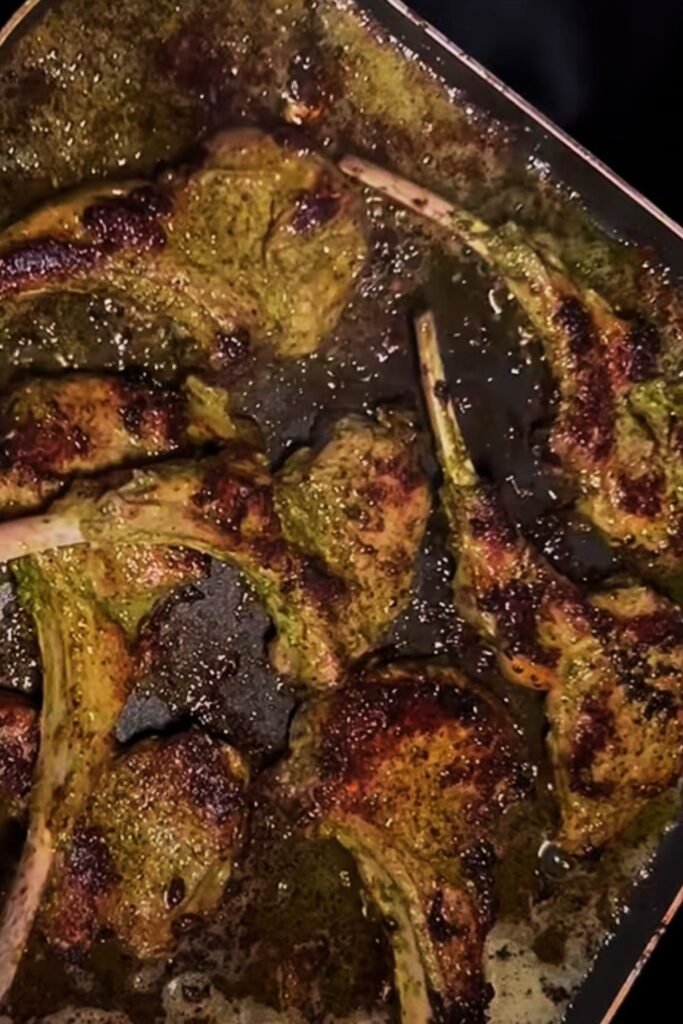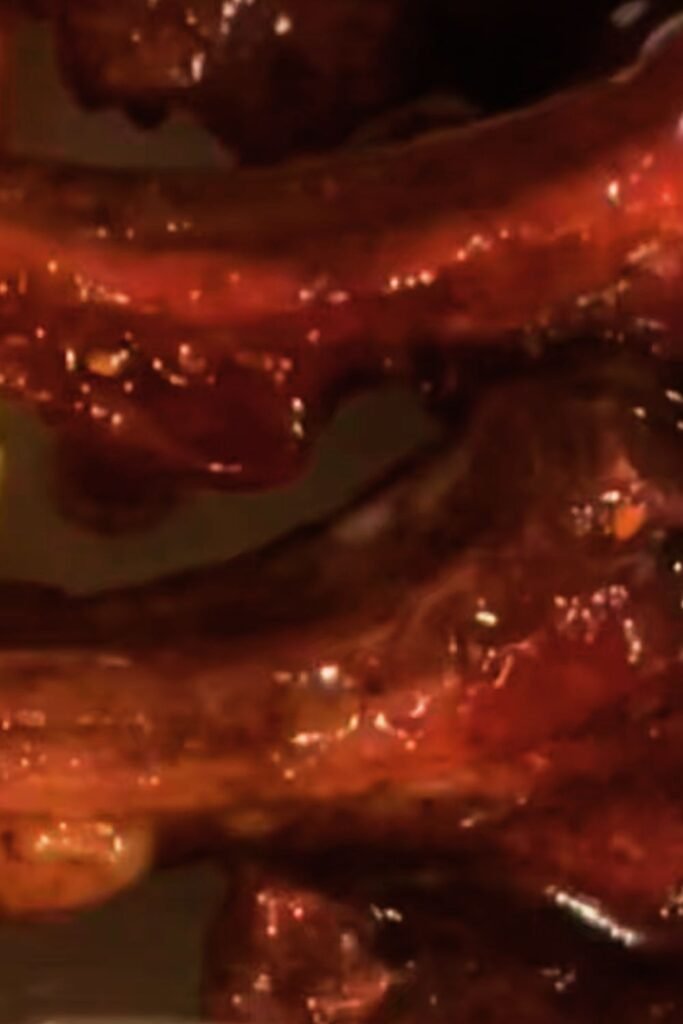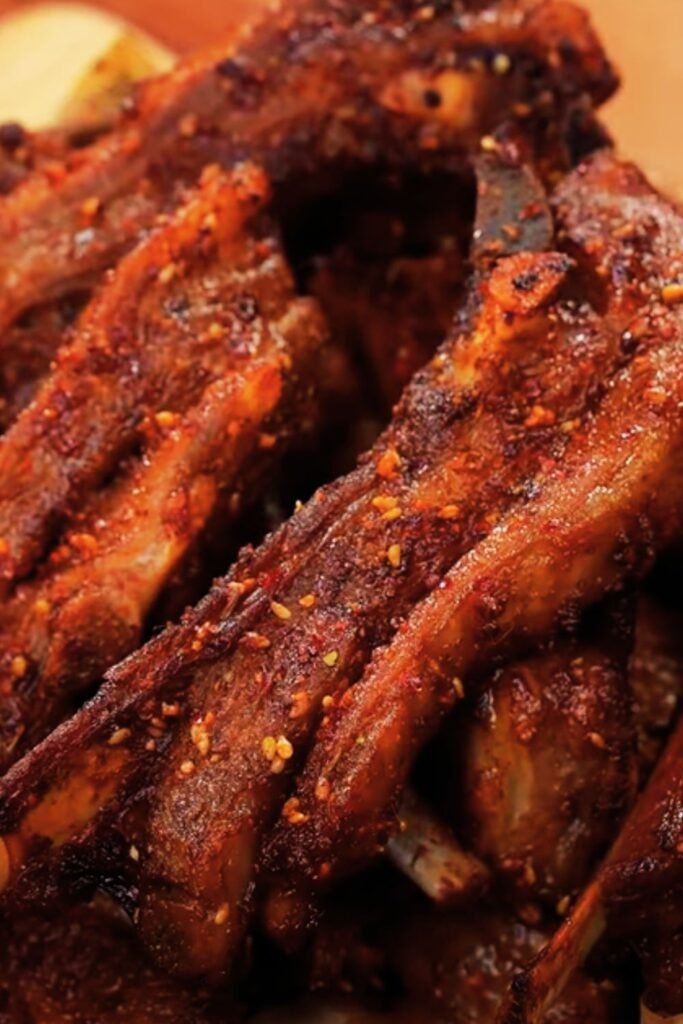When I first discovered the magical combination of tender lamb chops with the sweet-tart burst of pomegranate, I knew I had stumbled upon something extraordinary. This fancy pomegranate lamb chops recipe has become my go-to dish for special occasions, date nights, and whenever I want to impress my guests with minimal effort but maximum impact.
The beauty of this dish lies in its perfect balance of flavors and textures. The succulent lamb provides a rich, savory base while the pomegranate adds brightness and complexity that elevates the entire experience. I’ve served this dish countless times, and it never fails to generate compliments and requests for the recipe.
Understanding the Perfect Lamb Chop
Before diving into my signature pomegranate preparation, let me share what I’ve learned about selecting and preparing lamb chops through years of experimentation in my kitchen.
French-Cut Lamb Chops : Premium cuts with the fat cap trimmed and bones frenched for elegant presentation. These are my preferred choice for this recipe.
Rib Chops : Cut from the rib section, these offer excellent marbling and tenderness. Perfect for quick cooking methods.
Loin Chops : Leaner than rib chops but still incredibly flavorful. These work beautifully with the pomegranate glaze.
Shoulder Chops : More economical option that requires slightly longer cooking time but delivers exceptional taste.
The Magic of Pomegranate in Cooking
Pomegranates have been treasured in Middle Eastern and Mediterranean cuisine for centuries, and I’ve come to understand why they’re considered a superfood. Their unique flavor profile brings both sweetness and acidity to dishes, creating a complexity that few other ingredients can match.
Pomegranate Molasses : Concentrated pomegranate juice reduced to a syrup-like consistency. This is my secret weapon for intense flavor.
Fresh Pomegranate Juice : Provides natural sweetness and vibrant color. I always use freshly squeezed when possible.
Pomegranate Seeds (Arils) : Add textural interest and bursts of flavor. These jewel-like seeds make stunning garnishes.
Pomegranate Powder : Dried and ground pomegranate seeds that add tartness and depth to spice blends.
Essential Ingredients for Success
Through my culinary journey, I’ve discovered that the quality of ingredients directly impacts the final result. Here’s what I always keep on hand for this recipe:
| Ingredient | Quantity | Purpose | Quality Tips |
|---|---|---|---|
| Lamb Chops (French-cut) | 8 pieces | Main protein | Look for bright red color, minimal odor |
| Pomegranate Juice | 1 cup | Glaze base | Fresh-squeezed preferred, no added sugar |
| Pomegranate Molasses | 3 tablespoons | Flavor concentrator | Should be thick and glossy |
| Fresh Pomegranate Seeds | 1/2 cup | Garnish and texture | Plump, ruby-red, no brown spots |
| Honey | 2 tablespoons | Sweetness balancer | Raw honey provides better flavor |
| Garlic | 4 cloves | Aromatic base | Fresh bulbs, firm to touch |
| Fresh Thyme | 2 sprigs | Herbal complexity | Bright green, fragrant leaves |
| Rosemary | 1 sprig | Earthy depth | Fresh preferred over dried |
| Olive Oil | 1/4 cup | Cooking medium | Extra virgin, first cold-pressed |
| Salt | To taste | Flavor enhancement | Sea salt or kosher salt |
| Black Pepper | To taste | Spice element | Freshly ground for best flavor |
My Signature Pomegranate Lamb Chops Recipe
After perfecting this recipe through countless iterations, I’m excited to share my foolproof method that delivers restaurant-quality results every time.

Preparation Phase
I always begin by bringing my lamb chops to room temperature, which typically takes about 30 minutes. This crucial step ensures even cooking throughout the meat. While the lamb rests, I prepare my pomegranate glaze, which requires about 15 minutes of gentle simmering.
The Pomegranate Glaze
My glaze is what transforms ordinary lamb chops into an extraordinary culinary experience. I start by combining pomegranate juice, pomegranate molasses, and honey in a small saucepan. The key is maintaining a gentle simmer while whisking occasionally to prevent burning.
The mixture should reduce by about half, creating a glossy, syrup-like consistency that coats the back of a spoon. I add minced garlic and fresh thyme during the last few minutes of cooking, allowing the flavors to meld beautifully.
Cooking Method
I prefer using a combination of stovetop searing and oven finishing for optimal results. This technique gives me perfect control over the cooking process while ensuring a beautiful crust and even doneness.
First, I heat a cast-iron skillet over medium-high heat with a tablespoon of olive oil. Once the oil shimmers, I carefully place the seasoned lamb chops in the pan, ensuring they don’t overlap. The searing process takes about 2-3 minutes per side, creating that coveted golden-brown crust.
After searing, I brush the chops with my pomegranate glaze and transfer the skillet to a preheated 400°F oven. The finishing time depends on the desired doneness, but I typically aim for 6-8 minutes for medium-rare perfection.
Temperature Guide for Perfect Doneness
Understanding internal temperatures has revolutionized my lamb cooking. I invested in a quality meat thermometer, and it’s become indispensable for achieving consistent results.
| Doneness Level | Internal Temperature | Cooking Time | Visual Cues |
|---|---|---|---|
| Rare | 120-125°F | 4-5 minutes | Deep red center, cool |
| Medium-Rare | 130-135°F | 6-7 minutes | Warm red center, ideal |
| Medium | 140-145°F | 8-9 minutes | Light pink center |
| Medium-Well | 150-155°F | 10-11 minutes | Slightly pink center |
| Well-Done | 160°F+ | 12+ minutes | No pink, not recommended |
Flavor Variations That Excite
Over the years, I’ve developed several variations of this base recipe that showcase different flavor profiles while maintaining the pomegranate theme.
Middle Eastern Inspired : I add za’atar, sumac, and a touch of cinnamon to the glaze for an authentic regional taste.
Mediterranean Fusion : Fresh oregano, lemon zest, and a splash of balsamic vinegar create a bright, herbaceous variation.
Spicy Heat Version : A pinch of red pepper flakes and a dash of harissa paste bring warmth without overwhelming the delicate lamb.
Sweet and Savory : I incorporate dried figs and a touch of orange juice for a more complex sweet profile.
Side Dishes That Complement

Choosing the right accompaniments enhances the overall dining experience. I’ve experimented with numerous combinations and discovered these pairings work exceptionally well:
Grain-Based Sides : Wild rice pilaf with almonds and cranberries provides textural contrast and absorbs the delicious pan juices.
Vegetable Medleys : Roasted root vegetables like carrots, parsnips, and Brussels sprouts complement the lamb’s richness.
Starch Options : Creamy polenta or garlic mashed potatoes create a comforting base that balances the bright pomegranate flavors.
Fresh Elements : A simple arugula salad with lemon vinaigrette cuts through the richness and adds freshness.
Nutritional Benefits
Beyond its incredible taste, this dish offers impressive nutritional value. Lamb is an excellent source of high-quality protein, providing all essential amino acids. It’s also rich in iron, zinc, and vitamin B12, making it a nutritious choice for active individuals.
| Nutrient | Amount per Serving | Daily Value % | Health Benefits |
|---|---|---|---|
| Protein | 32g | 64% | Muscle development, satiety |
| Iron | 3.2mg | 18% | Oxygen transport, energy |
| Zinc | 4.8mg | 44% | Immune function, wound healing |
| Vitamin B12 | 2.8mcg | 117% | Nervous system health |
| Selenium | 28mcg | 51% | Antioxidant properties |
The pomegranate component adds powerful antioxidants, particularly punicalagins and anthocyanins, which support heart health and may have anti-inflammatory properties.
Storage and Reheating Tips
While this dish is best enjoyed fresh, I’ve developed techniques for storing and reheating leftovers that maintain quality and flavor.
For storage, I separate the lamb from any remaining glaze and store them in airtight containers in the refrigerator for up to three days. The glaze actually improves in flavor after a day, as the ingredients continue to meld.
When reheating, I avoid the microwave, which can make the lamb tough. Instead, I use a low oven (275°F) for about 10 minutes, brushing with reserved glaze to restore moisture and flavor.
Common Mistakes to Avoid
Through my cooking journey, I’ve made my share of mistakes with this recipe. Here are the most common pitfalls and how to avoid them:
Overcooking the Lamb : This is the most frequent error. Remember that lamb continues cooking after removal from heat. I always aim for slightly under my target temperature.
Burning the Glaze : High heat can quickly caramelize the sugars in pomegranate juice, creating bitter flavors. Always use medium-low heat and stir frequently.
Skipping the Rest Period : I never skip the resting phase after cooking. This allows juices to redistribute, ensuring moist, tender meat.
Inadequate Seasoning : Lamb has a robust flavor that can handle generous seasoning. I’m never shy with salt and pepper.
Wine Pairing Suggestions

The complex flavors of pomegranate lamb chops pair beautifully with several wine varieties. I’ve found that the key is balancing the fruit-forward glaze with the rich, savory lamb.
Red Wine Options : Pinot Noir complements the pomegranate’s tartness while not overpowering the delicate lamb. A medium-bodied Côtes du Rhône offers earthy notes that harmonize beautifully.
White Wine Alternatives : For those preferring white wine, a full-bodied Chardonnay or Viognier provides enough weight to stand up to the rich flavors.
Rosé Selection : A dry rosé from Provence creates a lovely bridge between the pomegranate’s fruitiness and the lamb’s savoriness.
Presentation and Plating
The visual appeal of this dish is nearly as important as its flavor. I’ve developed a plating technique that showcases the beautiful colors and textures while maintaining elegance.
I start with warm plates, which help keep the lamb at optimal serving temperature. A small pool of the pomegranate glaze in the center creates a glossy base for the chops. I arrange the lamb chops with bones pointing upward for height and drama.
Fresh pomegranate seeds scattered around the plate add jewel-like sparkles, while a sprig of fresh thyme provides an aromatic garnish. A light drizzle of extra glaze just before serving adds final shine and flavor.
Seasonal Adaptations
While this recipe works year-round, I’ve developed seasonal variations that incorporate fresh, local ingredients when available.
Spring Version : I add fresh mint and tender peas to complement the season’s bright flavors.
Summer Adaptation : Grilled preparation with fresh herbs from my garden creates a lighter feel perfect for warm weather.
Fall Enhancement : Roasted butternut squash and warming spices like cinnamon and allspice embrace autumn’s comfort.
Winter Comfort : Rich additions like roasted root vegetables and hearty grains make this perfect for cold weather entertaining.
Q&A Section
Q: Can I substitute other cuts of lamb for this recipe? A: Absolutely! While I prefer French-cut chops for their elegant presentation, you can use regular rib chops, loin chops, or even lamb leg steaks. Just adjust cooking times accordingly based on thickness.
Q: What if I can’t find pomegranate molasses? A: You can make your own by reducing pomegranate juice by about 80% until it becomes syrup-like. Alternatively, substitute with a mixture of pomegranate juice and a touch of honey or maple syrup.
Q: How far in advance can I prepare the pomegranate glaze? A: I often make the glaze up to three days ahead. It actually improves in flavor as it sits. Store it covered in the refrigerator and gently reheat before using.
Q: Can this recipe be doubled for larger gatherings? A: Yes, but I recommend using two skillets to avoid overcrowding. Overcrowded pans will steam the meat rather than sear it properly, affecting the final texture.
Q: What’s the best way to remove pomegranate seeds? A: I cut the pomegranate in half, hold it cut-side down over a bowl, and tap the back with a wooden spoon. The seeds fall out easily without the mess of picking them individually.
Q: Is there a vegetarian version of this dish? A: While you can’t replicate lamb exactly, I’ve had success using thick portobello mushroom caps or cauliflower steaks with the same pomegranate glaze treatment.
Q: How do I know when my lamb is perfectly cooked? A: Investment in a quality meat thermometer is essential. I aim for 130-135°F for medium-rare, which gives the perfect balance of tenderness and flavor.
Q: Can I freeze leftover cooked lamb chops? A: While possible, I don’t recommend freezing cooked lamb as it can become tough and dry. It’s better to use leftovers within 2-3 days for optimal quality.
This pomegranate lamb chops recipe has become more than just a meal in my kitchen – it’s become a celebration of flavor, technique, and the joy of cooking. Every time I prepare this dish, I’m reminded of why I fell in love with cooking in the first place: the ability to transform simple ingredients into something extraordinary that brings people together around the table.
The combination of tender, perfectly cooked lamb with the bright, complex flavors of pomegranate creates a dining experience that’s both sophisticated and approachable. Whether you’re preparing this for a special occasion or simply want to elevate your weeknight dinner, this recipe delivers consistent, impressive results that will have your guests asking for the recipe.
Remember, cooking is as much about the journey as the destination. Don’t be afraid to taste, adjust, and make this recipe your own. Some of my best culinary discoveries have come from happy accidents and bold experimentation. Trust your instincts, enjoy the process, and most importantly, share the delicious results with people you care about.